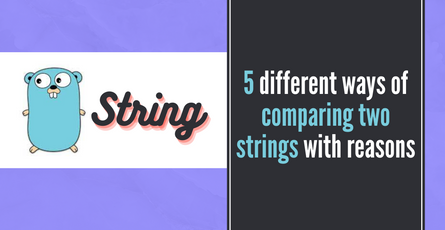
How to Convert integer to string type in Go?
You can convert integer to string type in golang using the Itoa() function from the strconv package. Learn about more methods to convert integer to string in go.-
 Sriram Thiagarajan
Sriram Thiagarajan
- February 18, 2023
How to Convert integer to string type in Go?
You can convert integer to string type in Go using the Itoa() function from the strconv package. This is helpful when you want to format your integer value into a sentence to log or print the value.
There are two main methods to use to convert integers to string
Itoa()function fromstrconvpackage can be used for most cases when dealing with integers of base 10 (Decimal number system) - Recommended for most scenarioFormatInt()function fromstrconvpackage can be used when the base of the integer is not 10 and you can specify the base of the integer to calculate the string value.
Convert integer to string using Itoa() - Method 1
package main
import (
"fmt"
"strconv"
)
func main() {
totalMarks := 320
totalMarksStr := strconv.Itoa(totalMarks)
fmt.Printf("The student has scored a total mark of %s out of 500", totalMarksStr)
}Output
The student has scored a total mark of 320 out of 500Syntax of the Itoa() function
func Itoa(i int) stringItoa() function represents the conversion of integer to string and is part of the strconv package. The function takes an integer as an argument and returns a string value
Itoa() function returns the equivalent to FormatInt(int64(i), 10). You can learn more about the FormatInt() function in the next section which is the advanced way of converting integers that are not base 10.
Convert integer to string using FormatInt - Method 2
FormatInt function is a more advanced way to format your Integer to string value. You can send the integer as the first argument and the second argument will be the base for the integer. If you want to convert the integer into a normal decimal numerical system of numbers from 0 to 9, you can send the base value as 10.
If you want to get the string of binary representation of the integer, you can pass the value of the base as 2
package main
import (
"fmt"
"strconv"
)
func main() {
totalMarks := 320
totalMarksStr := strconv.FormatInt(int64(totalMarks), 10)
fmt.Printf("The student has scored a total mark of %s out of 500", totalMarksStr)
}int64 function is used to convert the int type into an integer with 64 bits. In this case, since the FormatInt first argument is expecting the integer in int64, you will be converting the normal integer which is a 32-bit to a 64-bit integer.
Output
The student has scored a total mark of 320 out of 500Syntax of ParseInt() function
func FormatInt(i int64, base int) stringThe first argument is the integer which will be used to string based on the second argument. The second argument is the base which is the numeric base to convert. When converting to a decimal system (digits from 0 to 9), you can use the base of 10. Base 10 will be most used since most of the applications will be working on a Decimal numerical system
Conversion of integer to binary string in Golang
If you want to represent the integer in a binary string, you can use the base of 2
package main
import (
"fmt"
"strconv"
)
func main() {
totalMarks := 320
totalMarksStr := strconv.FormatInt(int64(totalMarks), 10)
fmt.Printf("The student has scored a total mark of %s out of 500\n", totalMarksStr)
totalMarkBinary := strconv.FormatInt(int64(totalMarks), 2)
fmt.Println("Binary - ", totalMarkBinary)
}Output
The student has scored a total mark of 320 out of 500
Binary - 101000000Conversion of integer to hexadecimal string in Golang
When you want to represent the integer in hexadecimal format, you can use the FormatInt function to get the hexadecimal string. This can be useful when you want to know the hex value of a specific channel in the RGB value of the colors.
package main
import (
"fmt"
"strconv"
)
func main() {
redColorValue := 142
hexValue := strconv.FormatInt(int64(redColorValue), 16)
fmt.Println("Hex Value -", hexValue)
}When the color of the red channel is 142, then the corresponding Hex value of the color will start with 8e, so it is easy to understand how the integer value is converted to hexadecimal.
Output
Hex Value - 8e

